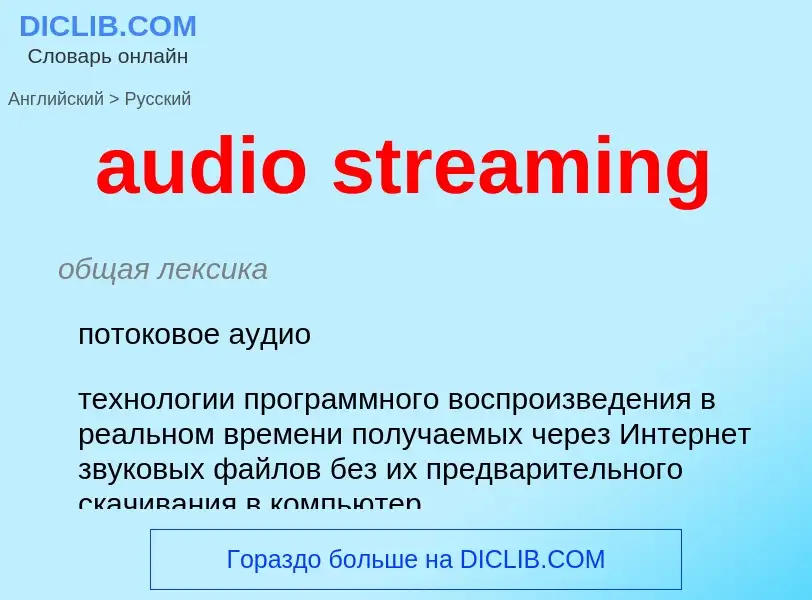Перевод и анализ слов искусственным интеллектом ChatGPT
На этой странице Вы можете получить подробный анализ слова или словосочетания, произведенный с помощью лучшей на сегодняшний день технологии искусственного интеллекта:
- как употребляется слово
- частота употребления
- используется оно чаще в устной или письменной речи
- варианты перевода слова
- примеры употребления (несколько фраз с переводом)
- этимология
audio streaming - перевод на Английский
общая лексика
потоковое аудио
технологии программного воспроизведения в реальном времени получаемых через Интернет звуковых файлов без их предварительного скачивания в компьютер
Смотрите также
['stri:miŋ]
общая лексика
потоковый
истечение
поток
протекание
течение
прилагательное
общая лексика
текучий и пр.
существительное
['stri:miŋ]
общая лексика
течение
вытекание и пр.
система потоков (в школах)
распределение школьников по классам в зависимости от их способностей
склонностей и т. п.
распределение учащихся по параллельным классам с учетом их способностей (в англ. школах)
добыча полезных ископаемых
промывка руды (в текучей воде)
математика
момент распределения
общая лексика
интерфейс прикладного программирования для голосовых (речевых) технологий, интерфейс SAPI
разработан корпорацией Microsoft для Windows 95 и Windows NT. Позволяет включать в приложения распознавание речи и преобразование текста в речь
синоним
общая лексика
усилитель звуковой частоты
усилитель низкой частоты
общая лексика
Compact Disk-Digital Audio
формат CD-DA
стандарт CD-DA
формат цифрового аудио компакт-диска. Рассчитан на 73 минуты высококачественного звучания. В формате CD-DA сектор длинной 2353 байта содержит данные, обеспечивающие воспроизведение музыки в течение 1/75 секунды. Разработан фирмами Philips и Sony, известен также под названием Red Book audio
['pauə(r)'æmplifaiə]
общая лексика
PA
усилитель мощности
Определение
Википедия
Streaming media is multimedia that is delivered in a continuous manner from a source, with little or no intermediate storage in network elements. Streaming refers to the delivery method of content, rather than the content itself.
Distinguishing delivery method from the media applies specifically to telecommunications networks, as most of the traditional media delivery systems are either inherently streaming (e.g. radio, television) or inherently non-streaming (e.g. books, videotapes, audio CDs). There are challenges with streaming content on the Internet. For example, users whose Internet connection lacks sufficient bandwidth may experience stops, lags, or poor buffering of the content, and users lacking compatible hardware or software systems may be unable to stream certain content. With the use of buffering of the content for just a few seconds in advance of playback, the quality can be much improved.
Livestreaming is the real-time delivery of content during production, much as live television broadcasts content via television channels. Livestreaming requires a form of source media (e.g. a video camera, an audio interface, screen capture software), an encoder to digitize the content, a media publisher, and a content delivery network to distribute and deliver the content.
Streaming is an alternative to file downloading, a process in which the end-user obtains the entire file for the content before watching or listening to it. Through streaming, an end-user can use their media player to start playing digital video or digital audio content before the entire file has been transmitted. The term "streaming media" can apply to media other than video and audio, such as live closed captioning, ticker tape, and real-time text, which are all considered "streaming text".
Streaming is most prevalent in video on demand and streaming television services. Other services stream music or video games.


![Live streaming service at zoo by [[Niconico]] Live streaming service at zoo by [[Niconico]]](https://commons.wikimedia.org/wiki/Special:FilePath/羽村市動物公園 ニコ生 2017 (32782507624).jpg?width=200)
.jpg?width=200)

![McIntosh]] MC240 from 1961 with exposed vacuum tubes McIntosh]] MC240 from 1961 with exposed vacuum tubes](https://commons.wikimedia.org/wiki/Special:FilePath/Mcintosh-MC240-glow.jpg?width=200)
 FIIO Fujiyama for smartphone etc. headphones.jpg?width=200)
![Five rack-mounted audio power amplifiers used in a [[sound reinforcement system]]. Five rack-mounted audio power amplifiers used in a [[sound reinforcement system]].](https://commons.wikimedia.org/wiki/Special:FilePath/Professional PA power amps from Crest Audio and QSC with control modules in rack.jpg?width=200)
![Pyle]] two-channel power amplifier Pyle]] two-channel power amplifier](https://commons.wikimedia.org/wiki/Special:FilePath/Pyle Power Amplifier.jpg?width=200)
![Rear panel of a medium-sized [[sound reinforcement system]] located at one side of the stage at a pop concert. The setup includes the [[mixing console]] for the [[sound engineer]] (standing behind) and the power amplifiers which are partly stacked in a 19-inch rack on the right. Rear panel of a medium-sized [[sound reinforcement system]] located at one side of the stage at a pop concert. The setup includes the [[mixing console]] for the [[sound engineer]] (standing behind) and the power amplifiers which are partly stacked in a 19-inch rack on the right.](https://commons.wikimedia.org/wiki/Special:FilePath/Rear panel of mixing console and amplifiers at concert of band 'Dead Can Dance' in Barcelona, May 2022.jpg?width=200)

![Sony [[Discman]] D-E307CK portable CD player with 1-bit DAC. Sony [[Discman]] D-E307CK portable CD player with 1-bit DAC.](https://commons.wikimedia.org/wiki/Special:FilePath/Sony-Discman-D-E307CK.jpg?width=200)
